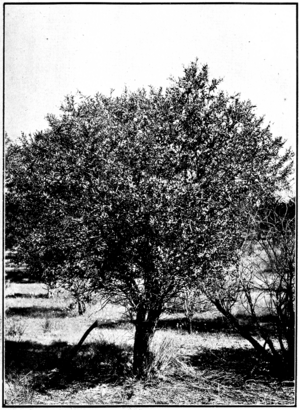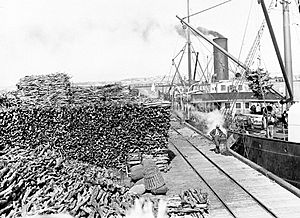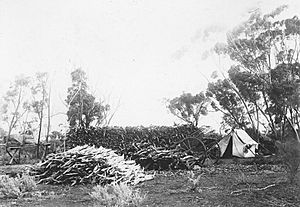Australian sandalwood facts for kids
Quick facts for kids Australian sandalwood |
|
|---|---|
 |
|
| A mature tree, circa 1920 | |
| Scientific classification | |
| Genus: |
Santalum
|
| Species: |
spicatum
|
The Santalum spicatum, often called the Australian sandalwood, is a special tree. It's also known by Aboriginal names like Waang (Noongar) and Dutjahn (Martu). This tree grows naturally in the dry parts of Western Australia.
Australian sandalwood is famous for its valuable wood and oil. People use its oil for nice smells, in medicines, and sometimes even as a food source. It's one of four important types of sandalwood found in Australia.
Contents
What's in a Name?
Local Aboriginal groups have different names for this tree. The Noongar peoples call it uilarac, waang, wolgol, or wollgat. The Martu people from the Gibson Desert call it dutjahn.
Meet the Sandalwood Tree
The Australian sandalwood is usually a shrub or a small tree. It can grow up to 6 meters (about 20 feet) tall. Its leaves are a pretty grey-green color. This tree is very tough. It can handle dry weather and salty soil well.
The tree produces round, orange fruits. Each fruit is about 3 centimeters (just over an inch) wide. Inside, there's an edible kernel with a hard shell. This shell is smoother than the deeply pitted shell of the quandong fruit. Sandalwood seeds usually sprout when it's warm and wet.
This tree is a "hemi-parasite." This means it gets some of its nutrients from the roots of other plants. It needs these host plants to grow strong.
Where Does it Grow?
Australian sandalwood used to be found all over the southwest of Australia. This included the Swan Coastal Plain and drier inland areas. However, its numbers have dropped a lot. This is because of too much harvesting and land clearing since the 1880s. Land was cleared mainly for growing wheat and raising sheep.
A small marsupial called the Woylie (Bettongia penicillata) helps spread the seeds. Woylies eat the seeds and bury them. Scientists believe they played a big role in spreading sandalwood before their own populations declined.
Sandalwood's Commercial Uses

Harvesting and exporting Australian sandalwood has been very important for Western Australia's economy. At one point, it made up more than half of the state's income! Money from sandalwood even helped speed up settlement in the Wheatbelt area.
In the 1920s, a forest expert named Charles Lane-Poole reported on its value. From 1845 until then, over 330,000 tons of sandalwood had been shipped. This was worth more than £3 million. Most of this wood went to China to make incense. People also started extracting oil from the wood. This oil was used for medicine.
Today, there's a smaller but still important source of sandalwood in the Quorn region of South Australia.
Scientists and companies have been researching how to grow the tree better. They also study the properties of its wood and nuts. Some landowners are replanting sandalwood trees. This helps restore the land, provides a food crop, and offers a future harvest. A company in Albany, Western Australia produces sandalwood oil. This oil can be worth about A$1,000 per kilogram!
The area of sandalwood plantations has grown a lot. It went from 7 square kilometers in 2000 to 70 square kilometers in 2006. About 2,000 tonnes of sandalwood are exported each year. Most of this still comes from wild trees in remote areas of Western Australia. However, the amount harvested from wild trees is less than it was in the 1800s.
According to AgriFutures Australia, the Western Australian sandalwood industry provides about 40% of the world's sandalwood oil.
Since 2017, Aboriginal Australians have been involved in producing the oil. The Dutjahn Custodians, who represent the Martu people, help manage a company. This company works with the land where sandalwood is harvested in the Gibson Desert. Harvesters stay at a small community called Mungilli. The company has a distillery in Kalgoorlie. They sell their oil to big names in the industry, like Estee Lauder.
Growing Sandalwood Trees
Getting sandalwood seeds to sprout can be tricky. It might even depend on weather patterns like El Niño. One successful method is to put the kernels in moist vermiculite inside sealed plastic bags at room temperature. Once they sprout, the tiny plants should be placed next to another seedling. This "host" plant helps the sandalwood grow.
The best host plant for plantations is Acacia acuminata. This acacia helps the sandalwood grow for 15 to 30 years. Other good host plants include rock sheoak (Allocasuarina huegeliana), wodjil (Acacia resinimarginea), and mulga (Acacia aneura).
What's in the Oil?
The oil from the Australian sandalwood tree contains many different chemicals. Many of these chemicals have qualities that can fight germs. The oil also contains a special acid called ximenynic acid.
See Also
 In Spanish: Sándalo australiano para niños
In Spanish: Sándalo australiano para niños


